Beverages offering ‘-biotics’ are on-trend
With the rising popularity of healthy, functional beverages, prebiotic, probiotic and synbiotic drinks are rising in the ranks.

This article is part of Food & Beverage Insider’s July Healthy Beverage theme that explores opportunities and innovation in the beverage sector. Throughout the month we will provide industry insight into growth categories, investigate novel clean ingredients and formulation strategies, address regulatory compliance and toast successes.
Digestive health, the microbiome, and connections between the gut and brain are trending topics in wellness—as is the potential for probiotics to positively influence some mechanisms of immune health (Ann Nutr Metab. 2019;74:115-124).
Consider these hot topics in light of ready-to-drink (RTD) beverages, and prebiotics and probiotics come to the fore. Drinkable yogurt, kefir and kombucha are nothing new, yet companies continue to introduce innovative offerings, with retail shelves and consumers becoming increasingly accepting. Likewise, unique beverage launches featuring prebiotics, probiotics or both (referred to as synbiotics) are contributing to growth in the space. And keep an eye out for postbiotics, which are basically inanimate byproducts of probiotic activity that offer a potential benefit to health.
What’s in a name?
Definitions are a good starting point in this space. In an age of heightened transparency, it would be disingenuous to suggest consumers support digestive health solely by eating any yogurt—especially if they choose one with high sugar content and low levels of beneficial bacteria.
Probiotics were initially defined in 2001 by an expert panel through the work of the Food and Agricultural Organization of the United Nations and the World Health Organization (FAO/WHO). In 2013, the International Scientific Association for Probiotics and Prebiotics (ISAPP) convened another expert panel to review the term and state of the science. From that, the widely accepted scientific definition for probiotics became, “Live microorganisms that, when administered in adequate amounts, confer a health benefit on the host.”
Based on this standard, the ISAPP website points out that although many foods and beverages may contain live microorganisms, only those that include “characterized strains with a scientifically demonstrated effect on health should be called probiotics.” Further, the association suggested, “Live microbes present in traditional fermented foods and beverages such as kombucha, sauerkraut and kimchi typically do not meet the required evidence level for probiotics, since their health effects have not been confirmed and the mixtures are largely uncharacterized.”
As part of the panel’s work in 2013, the group agreed consumption of foods containing live microbes might be a beneficial dietary recommendation, but it also recognized the challenges of scientifically qualifying diverse matrices of foods and beverages to ensure individual products met the criteria. As such, the panel recommended “such foods are best described as ‘containing live and active cultures,’ but should not be called probiotic” (Nat Rev Gastroenterol Hepatol. 2014;11:506-514). That said, it would be difficult to take issue with use of the term “probiotic” in beverages incorporating specific strains of beneficial probiotics in viable amounts verified at end of shelf life.
Through the years, ISAPP has also reviewed the scientific literature surrounding the term “prebiotic,” and via a panel in 2016, emerged with the consensus definition, “A substrate that is selectively utilized by host microorganisms conferring a health benefit.”
Essentially, prebiotics selectively stimulate growth of healthy gut bacteria such as Bifidobacteria and Lactobacilli, and may also promote healthy digestion (Nutrients. 2017;9[9]:1021). Synbiotics have both probiotic and prebiotic properties, and were initially created in an attempt to help overcome some possible difficulties for probiotics surviving in the gastrointestinal (GI) tract.
According to the book, “Preparation and Processing of Religious and Cultural Foods,” prebiotics naturally exist in different dietary food products, “including chicory, sugar beet, Jerusalem artichoke, wheat, honey, banana, barley, tomato, rye, soybean, human’s and cow’s milk, peas, beans, etc., and recently, seaweeds and microalgae.”
Ingredients in action
From kombucha to bottled water, consumers are becoming accustomed to seeing probiotic beverages at retail. But broader “-biotic” exposure continues, thanks to innovative brands.
Lizzy Haucke founded Gist in 2020 and launched her first two prebiotic drink SKUs in May 2021. “I developed the Gist formula and our blends during the pandemic in my farm kitchen, brewing herbs and prebiotics in Ball jars. I loved seeing my kids' reactions to each one and could tell pretty quickly what was going to work from a flavor perspective,” she shared. Also important in this was the herb selection. “Each one is brewed so you're getting not only the flavor but also the function out of each one,” Haucke noted.
She said she went with a prebiotic drink because “digestion is a core element of self-care that often gets overlooked. All of us are processing so much mentally, physically, emotionally every day—especially now as we come out of the pandemic year. So I was interested in finding an everyday way to enhance the body's ability to digest.”
Haucke also opted for a formulation free of added sugar or any type of sweetener—a decision that will appeal to consumers looking to avoid these ingredients, but that also might be an adjustment for those used to the American standard of oversweet. Confident, she stated, “We're letting the innate goodness of the herbal and prebiotic ingredients shine through.”
Another business pushing the envelope is Goodwolf Feeding Co., the creators of Goodwolf Probiotic Tonic—a water kefir that’s essentially a probiotic sparkling water.
When asked if the company has had to devote a lot of resources to educating consumers about water kefir, Goodwolf’s owner Keenan Smith replied, “Thankfully GT Dave [owner of GT’s Living Foods, whose kombucha controls around 40% of the U.S. market, according to Forbes] launched an Aqua Kefir recently and has been putting a decent budget into education on water kefir. We are fine being a small fish, swimming next to a big shark. Goodwolf started with a DIY/punk ethic... do as much as possible with as little as possible. If we are able to benefit from someone else's marketing budget, well—that's a good thing. Also, I don't think our target demo wants to be force-fed information; they are curious and want to explore new things. That kind of person is usually a trendsetter and will share the gospel of the Goodwolf goodness, organically,” he stated.
In fact, Smith hasn’t even ventured into trying to explain the full spectrum of his product’s functionality. “I personally don't think enough education has been done of probiotics to wrap a customer's mind around prebiotics,” he explained. “Water Kefir actually benefits from being both probiotic and prebiotic. There is a substance found in water kefir known as kefiran. It's a polysaccharide that acts as a prebiotic—but that's too much info for a label panel, obviously. So we don't go too deep into that stuff. … We just want to make a refreshing drink that is approachable, functional and delicious.”
Also of note, Goodwolf recently transitioned from glass bottles to cans. “Honestly, I would like to say that we ran some environmental impact analysis and decided it was best for the planet, etc., but the truth is that our bottle costs went up almost 40% during the past year,” Smith admitted. “We were really married to the shape and size of our bottle and weren't interested in moving to the standard kombucha or beer bottle. We initially fought the idea of premium brands being in aluminum cans and how customers might perceive it. However, once we saw other wonderful brands like Better Booch and Rowdy Mermaid moving into cans, we realized that the tides were turning.”
He also pointed to a perception shift with cans being viewed as more artisanal with popular hard kombucha and craft beer brands using them, such as JuneShine and Flying Embers. “It does have less of an environmental impact as well,” Smith acknowledged. “Our 6-pack case weight went from 8.4 pounds in glass bottles to 5 pounds in cans—a 40% decrease in freight—that's 40% less carbon emissions. And they are 100% recyclable.”
Market data
A February 2021 report from Market Research Future projected the global RTD beverage market (including alcoholic beverages) will reach US$950 billion by 2024. It also noted healthy drinks as a key driver, and that “the launch of innovative and exotic-flavored products with functional properties is expected to pave the way for lucrative opportunities in the market.”
The global prebiotics market is segmented into food and beverage, dietary supplements and animal feed. The relative newness of prebiotic beverage and its combined status with food in data compilation makes it difficult to quantify the market, although widespread growth is anticipated. A 2018 report from Grand View Research considered the market from 2014-2024. It noted that in 2015, “Food and beverage dominated the global prebiotics industry, accounting for 82% of global market volume,” and, “The presence of healthy promoting colon microorganisms in product-based food and beverages is expected to boost the application of prebiotics in food and beverages.” The report also projected a CAGR of 8% from 2016-2024.
A prebiotics report from Global Market Insights Inc. pegged the prebiotics market to surpass $9.5 billion by 2027. The firm noted the market exceeded $4.95 billion in 2020, and is estimated to grow at over 10.2% CAGR from 2021-2027. The authors noted, “Rising consumer demand for food and beverage products with reduced sugar and fat content without compromising on the taste and texture of the food products is likely to stimulate the demand for plant-based oligosaccharides such as prebiotics.”
Of note, the prebiotics market from dairy products application was valued at over $3.5 billion in 2020, and is expected to register over 10.1% CAGR by 2027.
When it comes to probiotics, beverage data is more readily accessible—albeit varied in its current valuation and projection of the market.
Grand View Research placed the global probiotic drink market at $13.65 billion in 2019, with 6.1% CAGR from 2020-2027. The firm pointed out the offline channel segment led the market and accounted for more than 85% of the global revenue in 2019, but the online channel is expected to expand faster over the forecast period. Similarly, dairy-based products held the largest revenue share of more than 55% in 2019, but the plant-based product segment is anticipated to witness faster growth through 2027.
In exploring the probiotic drinks market from 2016-2026, Mordor Intelligence anticipates a CAGR of 7.5% from 2020-2025. The firm reported dairy-based probiotic drinks are the leading segment, followed by fruit-based, and that Asia-Pacific holds the major share of the probiotic drinks market, followed by Europe.
"Global Probiotic Drinks Market” (2020-2026) provided by Research and Markets expects the niche to reach $25.2 billion by 2026, rising at 9.5% CAGR during the forecast period.
More bullish in its estimate, Data Bridge Market Research is looking for the probiotic drink market to reach $69.4 billion by 2027, experiencing a growth rate of 8.2% from 2020-2027.
And in some kefir-specific insight, DataM Intelligence (DMI) predicted the global kefir market will see a compound annual growth rate (CAGR) of 5.4% from 2021-2028, with Western Europe and the U.S. fostering key growth. According to the Grand View Research probiotic report, in February 2020, the international supermarket Tesco reported a 400% increase in kefir demand in the U.K. over the prior 18 months.
Market makers
In large part thanks to researchers (and creative entrepreneurs), a variety of ingredients and processing techniques are allowing for greater innovation in -biotic beverages.
A few years ago, a female undergrad at the National University of Singapore (NUS) even found a way to infuse live beneficial bacteria into beer—a feat, considering hop acids and alcohol typically prevent the growth and survival of probiotics.
As for the current market, Teeccino organic roasted herbal teas and herbal “coffees” have always contained chicory root, a natural source of inulin, a prebiotic soluble fiber. However, the company’s Prebiotic Superboost Blends contain an additional two prebiotics—a vegan glucooligosaccharide and organic xylooligosaccahride (XOS). And the Mushroom Adaptogen Blends pair prebiotic chicory root with a range of plant and mushroom rock stars. No matter which line, flavor profiles like dark chocolate, butterscotch cream, maple and macadamia nut abound.
Australia-based Remedy kicked off summer with the U.S. launch of its shelf-stable Ginger Lemon Kombucha, Peach Kombucha, Mixed Berry Kombucha, Raspberry Lemonade Kombucha and Blood Orange Switchel ACV (apple cider vinegar). The brand—started almost a decade ago in Melbourne with a kombucha brewed on the kitchen table of founders Sarah and Emmet Condon—now produces more than 90 million cans and bottles per year. Remedy’s SCOBY (symbiotic culture of bacteria and yeast) dates back at least 50 years in Australia, originating from German backpackers who brought it on their travels. Using this core live culture and organic green and black tea handpicked in Sri Lanka, Remedy incorporates ingredients such as whole organic ginger, organic lemon juice, freshly brewed hibiscus tea, fruit extracts, stevia extract and erythritol. Handcrafted in small batches and long aged brewed for 30 days, the production process brews out the sugar.
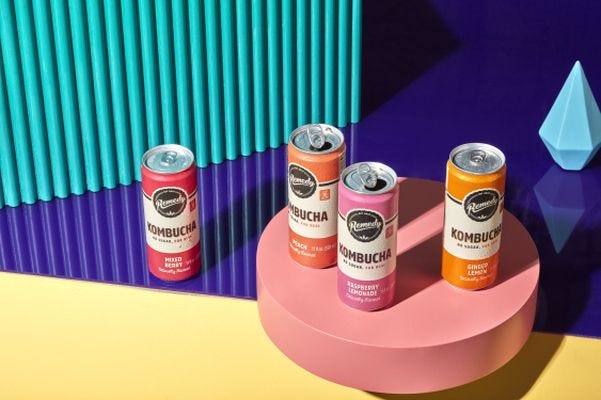
Launched in May 2021, Gist combines two hot trends—prebiotics and sparkling beverages. Cold-brewed with only five organically certified botanical ingredients, the earthy refresher pulls from steeped herbs, not extracts, and provides 4 g prebiotic fiber from sunchoke (also known as Jerusalem artichoke) in every 12-ounce can. Founder Lizzy Haucke said that’s about 14% of the daily recommended value, noting, “We decided on this amount because it's enough to have a meaningful effect and boost fiber intake, but also not so much as to cause discomfort.”
On a quest to foster positive gut-brain connections, Gist prebiotic sparkling beverage is free from caffeine, sugar or sweeteners, and has a base of carbonated water, Jerusalem artichoke inulin and lime juice. Ginger with Rooibos adds ginger root and rooibos tea; Chamomile with Rosemary incorporates chamomile flower and a hint of rosemary.
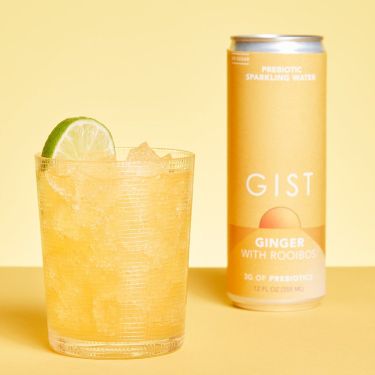
Uncle Matt's Organic is springboarding from its popular organic orange juice line to three beverage shots, each powered by a billion live probiotics (as Bacillus coagulans SNZ 1969 from Sanzyme Biologics) per serving. Manufactured using high-pressure processing (HPP), the fresh juice products require refrigeration.
• Ultimate Defense Shot is a concentrated blend of organic orange juice, pineapple, turmeric root, ginger, black pepper (for turmeric absorption) and live probiotics. It contains 1,000 percent daily value (%DV) vitamin C, 100% DV vitamin D and 100% DV zinc.
• Ultimate Immune Shot combines organic orange juice, black elderberry and probiotics. It offers 1,000% DV vitamin C, 100% DV vitamin D and 100% DV zinc.
• Ultimate Energy Shot is made from organic orange juice, mango and probiotics, and contains 200 mg of caffeine from coffeeberry extract. The formulation provides 1,000% DV vitamin C and 1,000% DV vitamin B12.
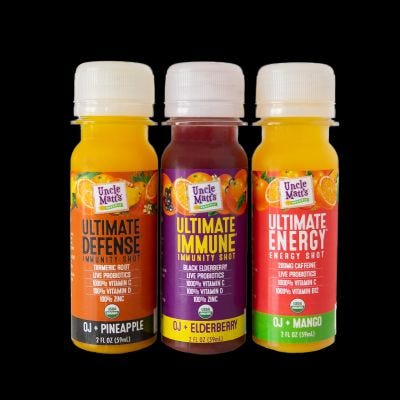
Small-batch, traditionally fermented Water Kefir is a probiotic tonic made by Portland, Oregon-based Goodwolf Feeding Co. Owner Keenan Smith considers the product “a bridge” between kombucha and sparkling water, and unlike a dairy kefir, water kefir is suitable for vegans. The brand launched its “core four” flavors in 2017, but added Tulsi Rose Lemon and Habanero Fire last year. When it came to inspiration for the latter, Smith said, “I had seen so many brands adding cayenne lemon SKUs to their selection and I thought, ‘Why not habanero? It's spicy but also more flavorful and rich than cayenne, more of a culinary ingredient and not just bland heat.’ We added cold-pressed organic ginger and lemon juice, plus a little ACV [apple cider vinegar] and it turned out to be a very well-balanced, sparkling and perfectly spicy tonic.”
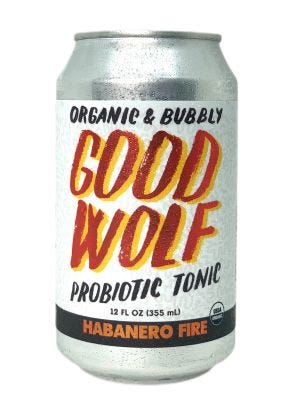
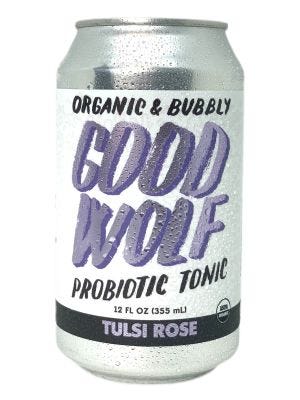
The 2021 NEXTY winner for Best New Organic Beverage, certified organic Kombucha Concentrate from Soda Press Co. was crafted for use with a SodaStream at-home carbonation machine. More than a year in development, the cold-fill, in-vessel, passive pasteurization process, use of brown glass bottles and concentrated form allows for a real kombucha with a long shelf life. Traditionally hand-brewed over 45 days, the shelf-stable (until opened) product contains more than a billion live probiotics (including Bacillus coagulans) and less than a gram of sugar per serving. The concentrates can be used to make homemade fancy sodas, cocktails, mocktails, slushies and more. Sustainability-focused and committed to ethical benchmarks, the company is plastic-free from end to end, using easy-to-recycle bottles made from recycled glass. Available in Original Unflavored, Zesty Ginger or Passionfruit & Mandarin, each 500 ml bottle makes more than a dozen drinks.
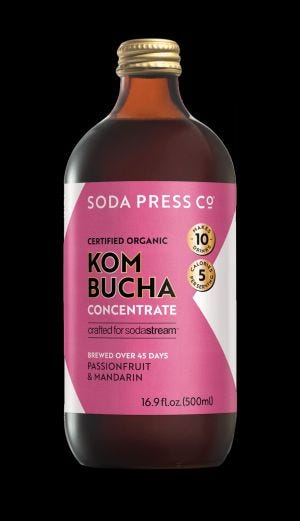
About the Author
You May Also Like

